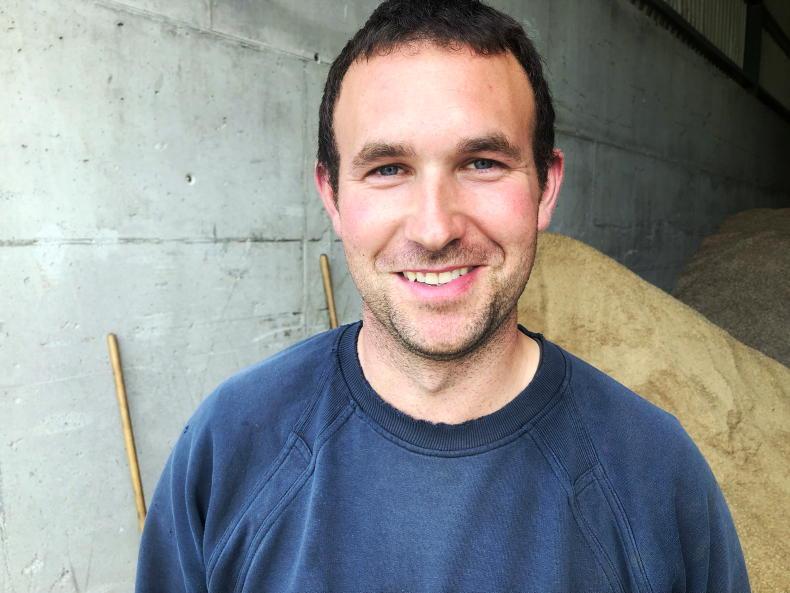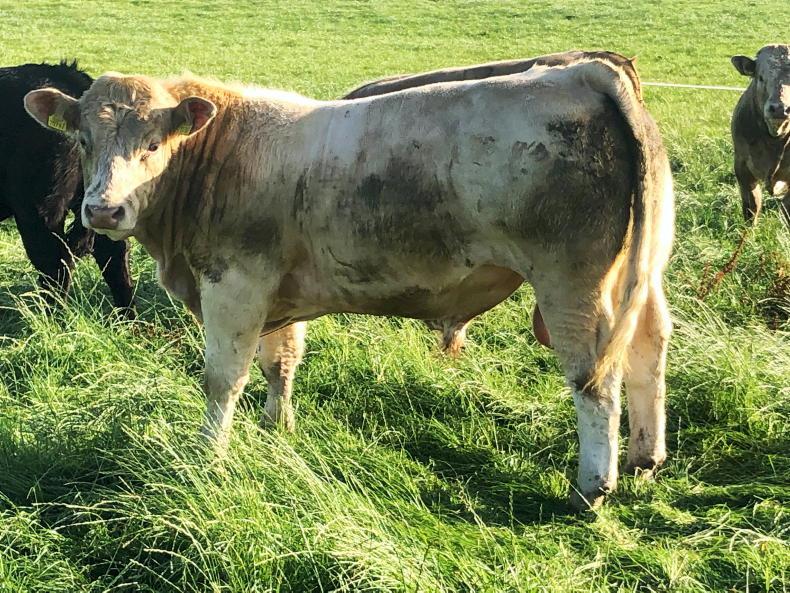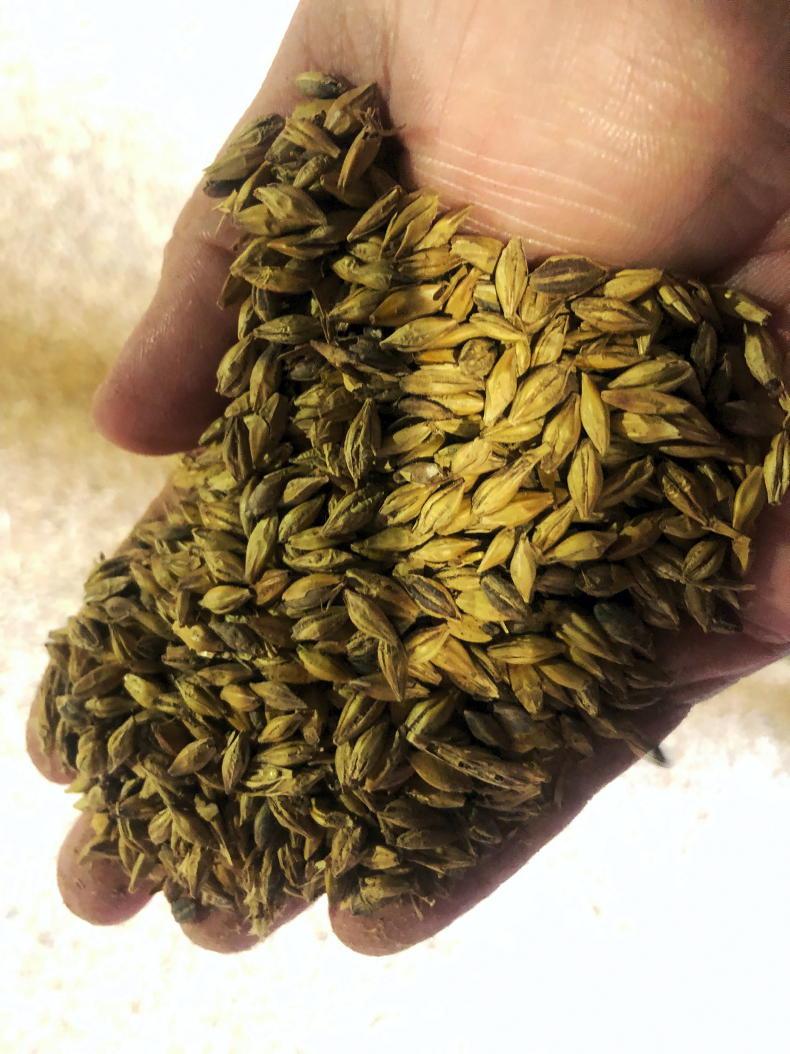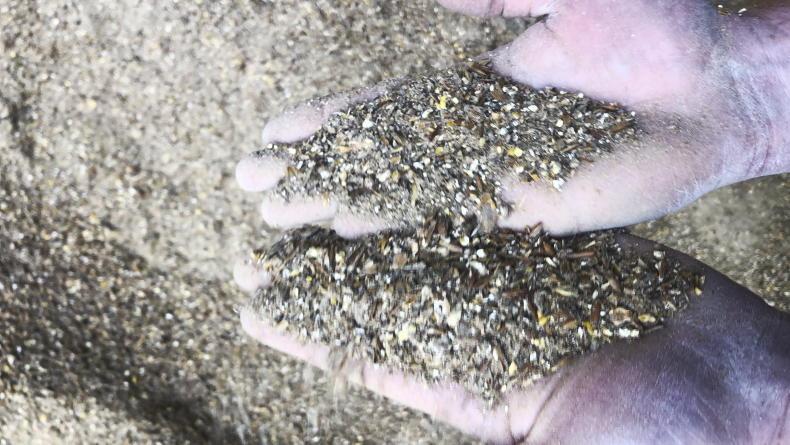Robert Moynan runs a busy operation just outside Rathdowney in Co Laois.
Along with a contacting business, the family farms sucklers, dairy cows and runs a substantial tillage operation.
Robert’s parents, Olive and Cecil, started it all back in the 1960s, with the family now farming over 500ac.

Robert Moynan farms just outside Rathdowney in Laois.
“We calve the sucklers in the autumn time and it sort of spreads out the workload a little. They also calve outdoors, which means there is very little work with them and there seems to be less issues around scours and sick calves in the autumn,” Robert said. The Moynans calve from August to December.
“We keep some of the heifers from the dairy herd as replacements, so the heifers generally end up calving around 30 months for the first time. We have some Hereford crosses, Aberdeen Angus crosses and Limousin crosses. We buy nothing in here except stock bulls.
“We actually tried using some Romangola bulls a few years ago and we’ve been really happy with the performance of the stock. Calves are very small at birth, but grow into good cattle very quickly. They also grade very well at slaughter. We run Charolais and Limousin bulls with the sucklers.

The Moynans calve from August to December.
“We have been purchasing bulls from Christy Comerford in Kilkenny for 20 years and we’re really happy with the way the stock perform out of them. We also run a Limousin bull with the heifers.”
The Moynans are finishing the male calves from the suckler herd as bulls, with a lot of them going as under-16-month bull beef. Performance is important, and Robert says the BEEP weighing scheme has really opened his eyes to the performance of stock.
“Some calves can surprise you when you weigh them and they are not always out of the fancy cows,” he said. “We are aiming to have the bulls around the 500kg mark at 12 months of age. Heifers from the suckler herd are killed off grass at 20-22 months during the summer period.”
Dairy beef
Sixty to 70 homebred stock out of the dairy herd are also finished annually. These are generally early maturing Herefords or Aberdeen Angus. Some heifers are killed off grass at 18-20 months, with the remainder being killed out of the shed during the winter. Bullocks from the dairy herd are slaughtered during the second winter.
“The big thing with these cattle is to avoid them going too fat at too young of an age. We have more control here in terms of what genetics we use in the dairy herd and I suppose we never went down an extreme route with the Friesians, because we knew in the back of our head we would be finishing the progeny.”
Propcorn shortages
Earlier this year, two of the largest producers of propionic acid reported delivery and production problems. This has resulted in a shortage of organic acids on the world market.
Propionic acid, or propcorn as it is commonly referred to, may seem to have ample supply, but supply to farmers who treat and preserve their own grain is limited, with some forced to look at other options for treating grain.

This has meant some farmers have had to look at alternative grain treatment options. Robert has been using a product called Grain pHro for the last few years on his farm. It’s a urea-based treatment with an enzyme added. You treat 1t of barley with 15kg of feed-grade urea and 5kg of the Grain pHro enzyme.
According to the manufacturers of the product, grain can be treated between 15-20% moisture and stored for a number of months.

The Moynans use a diet feeder for application and then cover the grain with polythene for a few weeks. The cover is then taken off and the grain can be stored up to 8ft high in a dry shed.
Once it is treated, it can be rolled at any stage after seven days. Grain pHro has the added advantage of increasing the pH of the grain up to pH 9.2, which means there is a reduced risk of acidosis when feeding it out.
It also increases the protein of the grain, meaning that no purchase of other sources of protein is required. Barley generally comes in at 8-10% protein, with Grain pHro-treated barley coming in at 12.5-14.5%.

The cost of the product is €26 to treat 1t of barley (Grain pHro and urea). If you need to get a contractor to treat it, you would be talking about €15/t to apply the product and another €10-€15/t to roll it for feeding.
Robert said they have noticed fewer digestive upsets since they started to use the product, as well as fewer foot problems with the animals on the finishing diet.
“We have actually even been feeding the Grain pHro barley through the parlour whenever we are feeding the milking cows. It cuts out a lot of messing with different rations on the farm.”
Winter diets
The Moynans use a lot of the feed they produce on the farm, apart from a very small amount of bought-in soya and maize meal, depending on prices.
“We work with a barley-based diet and mix in other feeds, depending on the type of stock we are feeding. We try to keep things as simple as we can during the winter feeding period – that’s why we started using the Grain pHro product.
“It was Angus Giggins, our nutritionist, who recommended we have a look at using it and we have been using it ever since. We use the diet feeder to put the product on the grain and then we’ll roll it as we need it during the winter months.”
“Last year’s bull finishing diet was 11kg of treated rolled barley, 7kg of fodder beet, 4kg of silage and 0.4kg of straw. Bulls were on this diet for about 100 days, with weight gains of around 1.8kg/day.
“Last year’s ration was costing €220/t. Bulls are fed in slatted pens, but have a straw lie-back to go back and lie on.
“We include some oats in the weanling rations. I don’t know what it is about the oats, but you can see the shine on cattle that are fed oats. It’s a very safe feed and we wouldn’t feed cattle without it in the diet,” Robert said.
Robert Moynan runs a busy operation just outside Rathdowney in Co Laois.
Along with a contacting business, the family farms sucklers, dairy cows and runs a substantial tillage operation.
Robert’s parents, Olive and Cecil, started it all back in the 1960s, with the family now farming over 500ac.

Robert Moynan farms just outside Rathdowney in Laois.
“We calve the sucklers in the autumn time and it sort of spreads out the workload a little. They also calve outdoors, which means there is very little work with them and there seems to be less issues around scours and sick calves in the autumn,” Robert said. The Moynans calve from August to December.
“We keep some of the heifers from the dairy herd as replacements, so the heifers generally end up calving around 30 months for the first time. We have some Hereford crosses, Aberdeen Angus crosses and Limousin crosses. We buy nothing in here except stock bulls.
“We actually tried using some Romangola bulls a few years ago and we’ve been really happy with the performance of the stock. Calves are very small at birth, but grow into good cattle very quickly. They also grade very well at slaughter. We run Charolais and Limousin bulls with the sucklers.

The Moynans calve from August to December.
“We have been purchasing bulls from Christy Comerford in Kilkenny for 20 years and we’re really happy with the way the stock perform out of them. We also run a Limousin bull with the heifers.”
The Moynans are finishing the male calves from the suckler herd as bulls, with a lot of them going as under-16-month bull beef. Performance is important, and Robert says the BEEP weighing scheme has really opened his eyes to the performance of stock.
“Some calves can surprise you when you weigh them and they are not always out of the fancy cows,” he said. “We are aiming to have the bulls around the 500kg mark at 12 months of age. Heifers from the suckler herd are killed off grass at 20-22 months during the summer period.”
Dairy beef
Sixty to 70 homebred stock out of the dairy herd are also finished annually. These are generally early maturing Herefords or Aberdeen Angus. Some heifers are killed off grass at 18-20 months, with the remainder being killed out of the shed during the winter. Bullocks from the dairy herd are slaughtered during the second winter.
“The big thing with these cattle is to avoid them going too fat at too young of an age. We have more control here in terms of what genetics we use in the dairy herd and I suppose we never went down an extreme route with the Friesians, because we knew in the back of our head we would be finishing the progeny.”
Propcorn shortages
Earlier this year, two of the largest producers of propionic acid reported delivery and production problems. This has resulted in a shortage of organic acids on the world market.
Propionic acid, or propcorn as it is commonly referred to, may seem to have ample supply, but supply to farmers who treat and preserve their own grain is limited, with some forced to look at other options for treating grain.

This has meant some farmers have had to look at alternative grain treatment options. Robert has been using a product called Grain pHro for the last few years on his farm. It’s a urea-based treatment with an enzyme added. You treat 1t of barley with 15kg of feed-grade urea and 5kg of the Grain pHro enzyme.
According to the manufacturers of the product, grain can be treated between 15-20% moisture and stored for a number of months.

The Moynans use a diet feeder for application and then cover the grain with polythene for a few weeks. The cover is then taken off and the grain can be stored up to 8ft high in a dry shed.
Once it is treated, it can be rolled at any stage after seven days. Grain pHro has the added advantage of increasing the pH of the grain up to pH 9.2, which means there is a reduced risk of acidosis when feeding it out.
It also increases the protein of the grain, meaning that no purchase of other sources of protein is required. Barley generally comes in at 8-10% protein, with Grain pHro-treated barley coming in at 12.5-14.5%.

The cost of the product is €26 to treat 1t of barley (Grain pHro and urea). If you need to get a contractor to treat it, you would be talking about €15/t to apply the product and another €10-€15/t to roll it for feeding.
Robert said they have noticed fewer digestive upsets since they started to use the product, as well as fewer foot problems with the animals on the finishing diet.
“We have actually even been feeding the Grain pHro barley through the parlour whenever we are feeding the milking cows. It cuts out a lot of messing with different rations on the farm.”
Winter diets
The Moynans use a lot of the feed they produce on the farm, apart from a very small amount of bought-in soya and maize meal, depending on prices.
“We work with a barley-based diet and mix in other feeds, depending on the type of stock we are feeding. We try to keep things as simple as we can during the winter feeding period – that’s why we started using the Grain pHro product.
“It was Angus Giggins, our nutritionist, who recommended we have a look at using it and we have been using it ever since. We use the diet feeder to put the product on the grain and then we’ll roll it as we need it during the winter months.”
“Last year’s bull finishing diet was 11kg of treated rolled barley, 7kg of fodder beet, 4kg of silage and 0.4kg of straw. Bulls were on this diet for about 100 days, with weight gains of around 1.8kg/day.
“Last year’s ration was costing €220/t. Bulls are fed in slatted pens, but have a straw lie-back to go back and lie on.
“We include some oats in the weanling rations. I don’t know what it is about the oats, but you can see the shine on cattle that are fed oats. It’s a very safe feed and we wouldn’t feed cattle without it in the diet,” Robert said.











 This is a subscriber-only article
This is a subscriber-only article











SHARING OPTIONS: